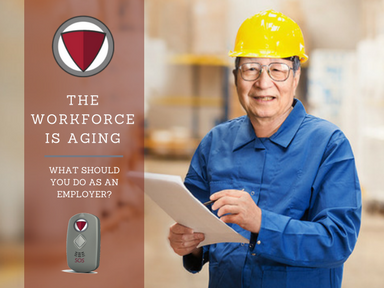
The Canadian workforce is aging, and an aging workforce means aging employees in the workplace. According to the Canadian Centre for Occupational Health and Safety; one in four workers in Canada could be an aging worker. So, what does an aging workplace mean to organizations?
- Taking extra caution, as older employees might be prone to falls due to poor balance, slower reaction time and visual impairment.
- New safety measures in the workplace in case of medical emergencies, due to health problems, such as diabetes, hypertension or osteoporosis. Aging workers may need fast assistance in times of a medical emergency.
- Consider redesigning the workplace to avoid injuries that may take longer to recover from.
Extra Caution
Employers need to understand that with age, workers may have physical and psychological changes occur which may affect their performance. However, an aging employee does not mean that they’re not capable of performing their day-to-day functions. It means that they need a different routine, and perhaps a different pace at which they can optimize their daily experience.
The fact of the matter is that you cannot expect a 25-year-old employee and a 55-year-old employee to perform at the same level and speed. Both employees bring different skills and assets to the workplace. Older employees mean experience, knowledge, and expertise.
New Safety Measures in the Workplace
Your workplace also needs to grow and develop to fit the needs of your aging employees better. Employers must recognize the safety implications associated with aging workers. A proper assessment of physical effects that the work might have on older workers is necessary by the employer to avoid workplace injuries.
Redesign of the workspace
With a little advanced planning, older employees can continue to be productive in the workplace. Employers must give special consideration to aging workers to ensure their safety and maintain productivity. To minimize distractions, employers can consider a workplace redesign. Reconstructing a working environment may cost the organization money, however, an injured employee that takes longer to recover may cost the employer more in the long run.
What Can Employers Do?
As an employer, you have the responsibility to keep employees safe and conduct risk assessment procedures that take into consideration specific employee’s needs to be safe at work.
Educate employees and provide training on what to do in case of an emergency. Educate aging workers on how to avoid workplace injuries.
Develop safe work procedures to help prevent injuries or emergencies. Providing employees with mobile alert pendants, such as CHECKMATE SOS can help them in the event of an emergency. CHECKMATE SOS can be used for any employee and can travel with them wherever they go. For more information, please click here.
For more information on CHECKMATE SOS contact us today!
